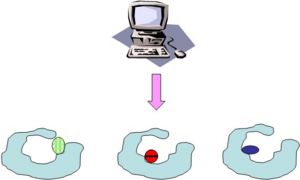Molecular docking: Difference between revisions
Jump to navigation
Jump to search
No edit summary |
mNo edit summary |
||
| Line 1: | Line 1: | ||
{{Wiktionary}} | {{Wiktionary}} | ||
[[Image:Docking.jpg|right|300px|]] '''Molecular docking''' is the process of posing and | [[Image:Docking.jpg|right|300px|]] '''Molecular docking''' is the process of posing, scoring and ranking small molecules in the binding sites of proteins. Typically, a large database of molecules is screened and ranked using a [[scoring function]], the top scoring compounds are reviewed in a [[hit picking party]] and then [[purchased]] and [[tested experimentally]]. | ||
[[Portal:DOCK | DOCK]] is the implementation of molecular docking and virtual screening that we develop and use at [[UCSF]]. | There are many good [[molecular docking programs]]. [[Portal:DOCK | DOCK]] is the implementation of molecular docking and virtual screening that we develop and use at [[UCSF]]. | ||
[[Category: | [[Category:Dictionary]] | ||
Revision as of 06:27, 23 November 2011
| File:Wiktionary-logo-en.svg | Look up molecular docking in Wiktionary, the free dictionary. |
Molecular docking is the process of posing, scoring and ranking small molecules in the binding sites of proteins. Typically, a large database of molecules is screened and ranked using a scoring function, the top scoring compounds are reviewed in a hit picking party and then purchased and tested experimentally.
There are many good molecular docking programs. DOCK is the implementation of molecular docking and virtual screening that we develop and use at UCSF.
